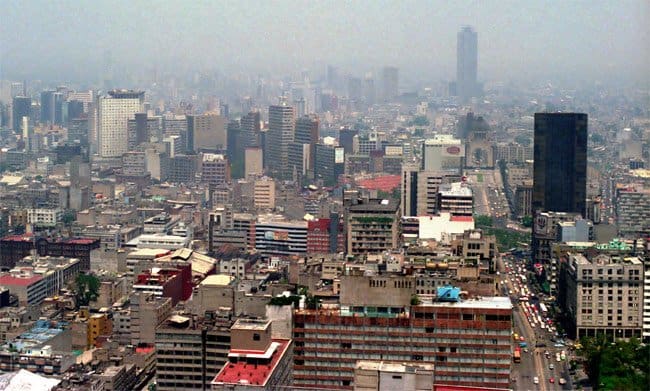Mexico – Mexico City
The city of Mexico City is absolute madness par excellence. In its dry lake bed at an altitude of 2240 m lies the city. Mexico City has the largest urban area in the world with about 2600 km². Mexico City is home to over 20 million people! Chaotic traffic conditions, unbelievable smog and a high crime rate do not invite at first glance to a longer stay. But there is a reason why you must have experienced this city: Mexico City is the cultural center of the country and has a turbulent history.
The high valley that extends over Mexico City is a veritable reservoir of the most beautiful and best, worst and ugliest of all that the country has to offer. The result of this mixture is a bustling, polluted giant city full of music and noise, smog and green lungs, full of colonial palaces, world-famous museums and unmanageable slums.
The historic center of Mexico City forms the Plaza de la Constitución, better known as the Zócalo. The square was built in the 1620s under Cortés, who paved it with stones from the ruins of the temples and palaces of the Aztec city of Tenochtitlán, on whose foundations Mexico City was built. Tenochtitlán was surrounded by a lake, so many of the older buildings and churches of today’s city are sinking slowly but surely in the marshy ground. We booked Mexico City just for a few days and begin our city tour on the second day of the trip at Zócalo, the city’s central square.
The entire east side of the Zócalo is occupied by the Palacio Nacional (National Palace). It was built on the foundations of an Aztec palace. Today, here are the offices of the President. There is also a museum with Diego Rivera murals documenting the history of Mexico. The Catedral Metropolitana can be found on the north side of the Zócalo. It was built there in the 1620s by the Spaniards. Formerly there was an Aztec tzompantli or skull wall (an altar on which the skulls were laid by the sacrificed).
The Cathedrale Metropolitana must be seen in any case. In 250 years of construction, from 1563 to 1813, the largest church of the entire continent was built. East of the cathedral are the remains of Templo Mayor. He is the most important of the Aztec temples. The Alameda, formerly an Aztec marketplace, is today a small park. The streets around the Alameda are lined with colonial villas, skyscrapers, cafés, restaurants, shops and markets.
Another absolute must for visitors is the Bosque de Chapultepec. It is the largest park in the city. Here are a hand full of museums, fairgrounds and the residence of the President. The Basilica de Guadalupe is a church built on the spot where the Mexican patron saint was supposed to have appeared. Worth seeing are also the colonial houses of San Angel as well as the Cuicuilco pyramid and the canals of Xochimilco. We also set out to “climb” the tallest building in Mexico, the Torre Latinoamericana. On the 41st floor there is a restaurant and above the restaurant there is a viewing platform.
The view is really worth seeing. From here you have a wonderful view of Mexico City. Especially nice is a visit in the late afternoon when the lights come on in Mexico City. Mexico City is a modern and cosmopolitan city located on the shores of a lake surrounded by volcanic mountains. The different cultures that have been native to this place over the centuries have produced a special and very idiosyncratic and interesting architecture of different styles. But Mexico City is not only the largest city in the world, it is also the cradle of Aztec culture.
If you want to have activities throughout the day, Mexico City is certainly the place to be. You can get museum visits, a never-ending nightlife, culture and entertainment here. The city offers art and cultural exhibitions spanning all eras, from the pre-colonial period (Museum of Anthropology) to the Modern (Museum of Modern Art), but also traditional, as seen in the Frida Kahlo Museum. Not far from Mexico City are the Pyramids of Sun and Moons in Teotihuacán. The pyramid of Cuicuilco in the south of the city is a special construction. It is half hidden and covered with the lava from an eruption of the volcano Xitle more than 3,000 years ago. The whole history and the transformation of this city over the different eras can be traced in the Anthropology Museum.
The main attractions are the Palace of Fine Arts, a monument of white marble built by a French architect and the Place of the Three Cultures. On the second day of our arrival in Mexico, we come back from visiting the museums in the evening and are completely exhausted. The exhaust air and the unaccustomed height of Mexico City (or both together) are causing us a lot of trouble. So we are glad to have arrived back at the Hotel Alameda to relax a bit. The hotel is centrally located and you can almost (almost) do everything on foot. We also have a nice view of the city from the roof terrace of the hotel.















